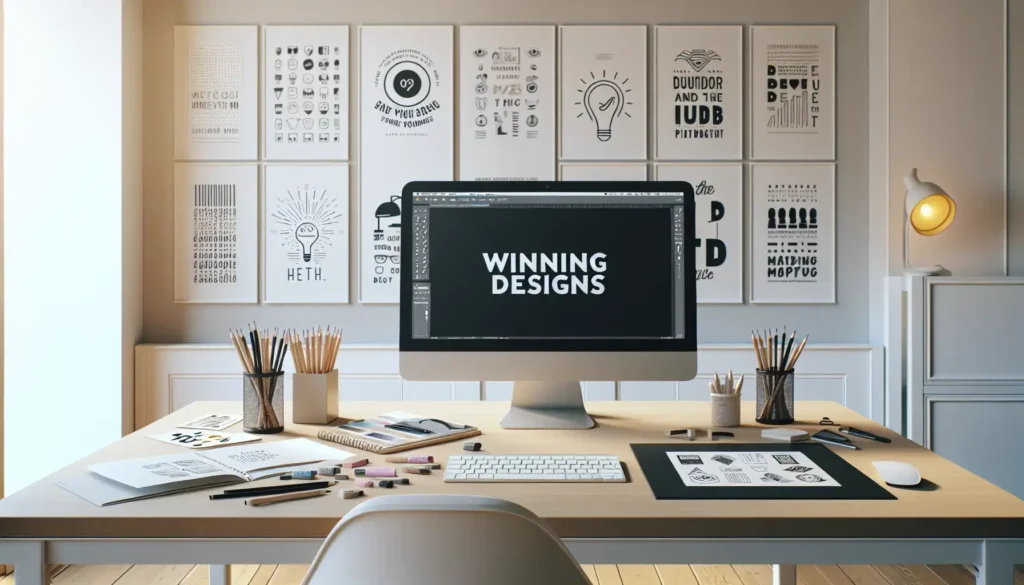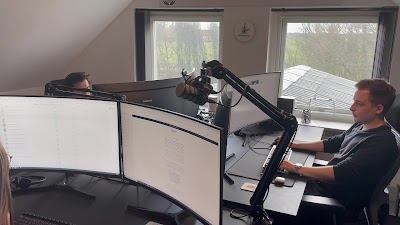A great design can make or break your print on demand (POD) store. In the competitive world of e-commerce, where thousands of new products launch daily, your design is often the only thing standing between a sale and a scroll-past. The harsh reality is that 80% of POD products that fail suffer from weak design, according to industry analysis of successful versus unsuccessful POD stores.
However, this statistic also reveals an incredible opportunity. If you can master the art of creating compelling print on demand designs, you’ll immediately set yourself apart from the majority of competitors. The difference between a design that sells and one that sits in digital obscurity often comes down to understanding your audience, following proven design principles, and knowing how to balance creativity with market demand.
In this comprehensive guide, you’ll learn how to create designs that not only capture attention but convert browsers into buyers. We’ll explore the common pitfalls that sink most POD businesses, introduce you to powerful tools that make professional design accessible to everyone, and reveal the current trends that are driving sales across multiple platforms. Most importantly, you’ll discover how to test and refine your designs before investing time and money in products that won’t sell.
The problem with overcomplicated print on demand designs
One of the biggest mistakes new POD entrepreneurs make is believing that more elements equal more value. This misconception leads to cluttered, confusing designs that overwhelm potential customers rather than attract them. When someone is browsing through hundreds of t-shirt options or coffee mug designs, they make split-second decisions based on immediate visual impact.
Customers want clarity, not clutter. A design should communicate its message within three seconds of viewing. If someone has to study your design to understand what it’s about, you’ve already lost the sale. This is especially true for mobile shoppers, who represent over 60% of e-commerce traffic and are viewing your designs on small screens.
Common overcomplification mistakes
The most frequent design errors include using too many fonts, cramming multiple messages into one design, and incorporating excessive colors or graphics. For example, a t-shirt design that tries to include a funny quote, multiple graphics, decorative borders, and various font styles will appear chaotic and unprofessional. Instead, successful print on demand designs typically focus on one clear concept executed flawlessly.
Another critical mistake is ignoring the product itself. A design might look great on a computer screen but become illegible when printed on a dark-colored shirt or reduced to fit a small mug. Therefore, always consider the final product dimensions and background colors when creating your designs.
The psychology of simple design
Simple designs work because they align with how our brains process visual information. The human eye naturally seeks patterns and clarity, and when presented with too much information, it tends to look away rather than try to decode the message. Moreover, simple designs appear more professional and trustworthy, which increases the likelihood of purchase.
Essential tools for creating professional print on demand designs
The democratization of design tools has made it possible for anyone to create professional-looking print on demand designs without years of training or expensive software. However, choosing the right tools can make the difference between spending hours on a single design and creating multiple high-quality designs in the same timeframe.
Canva for beginners and professionals
Canva has revolutionized the design industry by making professional design accessible to everyone. For print on demand designs, Canva offers thousands of templates specifically sized for popular POD products. The platform includes pre-made layouts for t-shirts, mugs, posters, and phone cases, which you can customize with your own text, colors, and graphics.
The key advantage of Canva is its extensive library of fonts, graphics, and stock photos. You can create cohesive brand aesthetics by using consistent color palettes and typography across all your designs. The Pro version, which costs around $12 per month, unlocks premium elements and the ability to resize designs for different products instantly.
When using Canva for print on demand designs, always export your files in high resolution (300 DPI) and ensure your designs meet the specific requirements of your chosen POD platform. Most platforms require PNG files with transparent backgrounds for optimal printing results.
Placeit for mockups and branding
Placeit specializes in creating realistic mockups that show how your designs will look on actual products. This tool is invaluable for print on demand businesses because it allows you to present your designs professionally without having to purchase and photograph sample products.
The platform offers thousands of mockup templates featuring real models wearing apparel, lifestyle shots of home decor items, and professional product photography setups. You simply upload your design, and Placeit automatically applies it to the mockup with realistic lighting, shadows, and proportions.
Placeit also includes design templates similar to Canva, but with a focus on commercial use. The subscription costs approximately $15 per month and includes unlimited downloads, making it cost-effective for businesses creating multiple designs regularly.
Free alternatives and budget-friendly options
For entrepreneurs just starting out, several free tools can help create professional print on demand designs. GIMP offers advanced image editing capabilities similar to Photoshop but without the monthly subscription fee. Figma provides excellent vector design tools and is particularly useful for creating scalable graphics that maintain quality at any size.
Google Fonts offers hundreds of free, commercial-use fonts that can elevate your designs. Unsplash and Pexels provide high-quality stock photos that you can incorporate into your designs, though always check the licensing terms for commercial use.
Design trends that sell in today’s market
Understanding current design trends is crucial for creating print on demand designs that resonate with today’s consumers. However, it’s important to distinguish between fleeting fads and lasting trends that will continue to drive sales over time. The most successful POD entrepreneurs identify trends early and adapt them to their unique brand voice.
Minimalist typography dominance
Minimalist typography has become increasingly popular across all design mediums, and print on demand products are no exception. Clean, simple fonts with plenty of white space create sophisticated designs that appeal to a broad audience. This trend works particularly well for motivational quotes, brand slogans, and lifestyle messaging.
The key to successful typographic designs lies in font selection and hierarchy. Sans-serif fonts like Helvetica, Montserrat, and Open Sans convey modernity and clarity, while serif fonts like Georgia and Times New Roman suggest tradition and reliability. Script fonts should be used sparingly and only when they enhance the message rather than distract from it.
Color plays a crucial role in minimalist typography. Monochromatic designs often perform better than multi-colored ones because they’re more versatile across different product colors and easier to produce cost-effectively. Black text on white backgrounds remains the most popular choice, followed by white text designs that work well on dark-colored products.
Humor-based graphics that connect
Humor is one of the most powerful tools in print on demand design because it creates an emotional connection with customers. Funny designs are more likely to be shared on social media, increasing organic marketing reach. However, successful humor-based designs require careful consideration of your target audience and current cultural references.
The most successful humorous print on demand designs often reference shared experiences, popular culture, or relatable situations. For example, designs about coffee addiction, pet ownership, or work-from-home life resonate with large audiences because they tap into common experiences.
When creating humor-based designs, ensure the joke is immediately understandable and won’t become dated quickly. Avoid controversial topics or humor that might alienate potential customers. The goal is to make people smile and feel connected to your brand, not to make bold statements that could limit your market appeal.
Lifestyle-focused art and imagery
Lifestyle-focused designs tap into people’s aspirations and identities. These designs often feature imagery or text that represents hobbies, professions, life philosophies, or personal interests. They’re particularly successful because they allow customers to express their identity through their purchases.
Popular lifestyle categories include fitness and wellness, travel and adventure, parenting, professional identities, and hobby-based communities. For example, designs targeting yoga enthusiasts might feature Sanskrit words, lotus flowers, or meditation-inspired quotes. Designs for dog lovers might include breed-specific illustrations or humorous sayings about pet ownership.
The key to successful lifestyle designs is authenticity and specificity. Generic designs rarely perform as well as those that speak directly to a particular community or interest group. Research your target audience thoroughly and create designs that demonstrate genuine understanding of their values and interests.
Testing your print on demand designs before launch
One of the most critical steps in creating successful print on demand designs is testing them before investing in product creation and marketing. This testing phase can save you significant time and money while providing valuable insights into what your target audience actually wants to buy.
Leveraging social media for design validation
Social media platforms offer powerful opportunities to test your designs with real audiences before committing to production. Create mockups of your designs on various products and share them across your social media channels. Pay attention to engagement metrics like likes, comments, shares, and saves, as these indicate genuine interest in your designs.
Instagram Stories polls and question stickers provide direct feedback mechanisms. You can present multiple design options and ask followers to vote for their favorites, or use open-ended questions to gather specific feedback about colors, sizing, or messaging. This approach not only validates your designs but also builds anticipation for your product launches.
Facebook groups related to your niche offer another valuable testing ground. Many communities welcome entrepreneurs sharing their work for feedback, provided you follow group rules and contribute value beyond self-promotion. The feedback you receive from potential customers in these groups is often more honest and detailed than what you’ll get from friends and family.
Gathering feedback from online communities
Reddit communities, Discord servers, and specialized forums provide access to engaged audiences who are often willing to provide detailed feedback on design concepts. Subreddits like r/design_critiques, r/entrepreneur, and niche-specific communities can offer valuable insights from both designers and potential customers.
When seeking feedback, be specific about what you want to know. Instead of asking “What do you think of this design?” ask targeted questions like “Would you wear this shirt to work?” or “Does this design make you want to learn more about the product?” This approach generates more actionable feedback that you can use to improve your designs.
Consider creating surveys using tools like Google Forms or Typeform to gather structured feedback. Include questions about price sensitivity, preferred product types, and design preferences. This data can inform not only your current designs but also your overall business strategy.
A/B testing strategies for POD designs
Once you’ve gathered initial feedback, consider running small-scale A/B tests with different design variations. Many POD platforms allow you to create multiple versions of the same product, enabling you to test which designs generate more sales with minimal upfront investment.
Test one element at a time to get clear results. For example, create two versions of the same design with different color schemes, or test the same message with different typography choices. Track not only sales numbers but also click-through rates, time spent on product pages, and conversion rates from view to purchase.
Document your testing results to build a knowledge base of what works for your audience. Over time, you’ll develop insights that can guide future design decisions and improve your overall success rate.
How to balance creativity with market demand
The tension between artistic expression and commercial viability is one of the biggest challenges facing print on demand designers. While creativity is essential for standing out in a crowded marketplace, designs that don’t align with market demand simply won’t sell. The most successful POD entrepreneurs learn to blend their creative vision with data-driven market insights.
Using trend tools effectively
Several tools can help you identify trending topics, keywords, and visual styles that are gaining popularity. Google Trends shows search volume changes over time for specific terms, helping you identify emerging opportunities before they become oversaturated. Pinterest Trends reveals what visual content is gaining traction, while tools like Exploding Topics identify rapidly growing search terms across various industries.
However, simply copying trending designs rarely leads to long-term success. Instead, use trend data as inspiration for creating original designs that incorporate popular elements while maintaining your unique style. For example, if you notice increasing interest in sustainability topics, you might create original designs that speak to environmental consciousness rather than copying existing eco-friendly slogans.
The key is to add your own twist to trending concepts. This approach allows you to capitalize on existing market demand while building a distinctive brand that customers will remember and return to for future purchases.
Developing your signature style
While following trends is important, developing a recognizable signature style sets you apart from competitors and builds brand loyalty. Your signature style might involve consistent color palettes, specific illustration techniques, particular typography choices, or a unique approach to humor or messaging.
Study successful POD businesses in your niche and analyze what makes their designs instantly recognizable. Notice how they adapt to trends while maintaining their core aesthetic. This consistency helps build trust with customers and makes your products more memorable in a crowded marketplace.
Document your style guidelines, including preferred fonts, color combinations, design layouts, and messaging tone. This documentation ensures consistency across all your designs and makes it easier to scale your business by working with freelance designers who can match your established style.
Market research techniques for designers
Effective market research goes beyond looking at competitor designs. Analyze bestseller lists on POD platforms, study customer reviews to understand what people love or dislike about existing products, and monitor social media conversations in your target niches.
Use keyword research tools like Ahrefs, SEMrush, or even free options like Ubersuggest to identify what terms people are searching for related to your design categories. This information can inspire new design concepts and help you optimize your product titles and descriptions for better discoverability.
Create customer personas based on your research, including demographics, interests, pain points, and shopping behaviors. These personas should guide your design decisions and help you create products that truly resonate with your target audience.
Technical considerations for print on demand designs
Creating visually appealing designs is only half the battle in the print on demand industry. Technical considerations like file formats, resolution, color modes, and sizing requirements can make or break your product quality. Understanding these technical aspects ensures your designs look professional when printed and helps avoid costly reprints or customer complaints.
File format and resolution requirements
Different POD platforms have varying technical requirements, but some standards apply across the industry. Most platforms prefer PNG files with transparent backgrounds for designs that don’t fill the entire product surface. This format allows for better placement flexibility and works well on products of different colors.
Resolution is critical for print quality. Always create designs at 300 DPI (dots per inch) to ensure crisp, professional printing. While 72 DPI might look fine on screen, it will appear pixelated and blurry when printed on physical products. For large format items like posters or canvas prints, you may need even higher resolutions to maintain quality.
Vector formats like SVG or AI files are ideal when possible because they can be scaled to any size without losing quality. However, not all POD platforms accept vector formats, so you may need to export high-resolution raster versions of your vector designs.
Color management and print considerations
Understanding color management prevents disappointment when your printed products don’t match what you see on screen. Computer monitors use RGB color mode (red, green, blue light), while printing uses CMYK (cyan, magenta, yellow, black ink). Colors often appear different between these two systems.
Design in RGB mode since most POD platforms handle the CMYK conversion automatically, but be aware that bright, saturated colors may appear duller when printed. Test your color choices by ordering sample products before launching full product lines, especially for designs where color accuracy is crucial.
Consider how your designs will look on different colored products. A design that looks great on a white t-shirt might be invisible on a light gray one. Create variations of your designs optimized for light and dark backgrounds to maximize your product options.
Sizing and placement guidelines
Each product type has optimal design dimensions and placement areas. T-shirt designs typically work best between 11-14 inches wide and should be positioned slightly above center chest. Mug designs need to account for the handle and should wrap around the product appropriately.
Create templates for each product type you plan to use, marking safe areas where your design will definitely print correctly. This approach speeds up your design process and reduces errors. Many POD platforms provide downloadable templates, but creating your own ensures consistency across your product line.
Consider how design placement affects production costs. Some platforms charge more for all-over prints or designs that extend to product edges. Factor these costs into your pricing strategy to maintain healthy profit margins.
Building a cohesive brand through your print on demand designs
Successful print on demand businesses don’t just sell individual products; they build recognizable brands that customers trust and return to repeatedly. Your designs play a crucial role in establishing this brand identity and should work together to create a cohesive experience across all customer touchpoints.
Developing brand consistency
Brand consistency in print on demand designs means maintaining recognizable elements across all your products while still offering variety to appeal to different customer preferences. This might involve using a consistent color palette, typography style, illustration approach, or messaging tone that makes your products instantly recognizable as part of your brand family.
Create a brand style guide that documents your chosen fonts, color codes, logo usage, and design principles. This guide ensures consistency whether you’re creating designs yourself or working with freelance designers. Include examples of designs that represent your brand well and counter-examples of styles to avoid.
Consider how your designs will look together in your online store. Products should complement each other visually and appeal to similar customer segments. A cohesive brand presentation increases customer confidence and encourages multiple purchases during single shopping sessions.
Storytelling through design
The most memorable print on demand brands tell stories through their designs. These stories might revolve around lifestyle aspirations, shared values, humor styles, or community identity. Customers buy into these stories as much as they buy the physical products, creating emotional connections that drive loyalty and word-of-mouth marketing.
Develop a brand narrative that resonates with your target audience and let this story guide your design decisions. For example, a brand focused on outdoor adventure might consistently use earthy colors, hand-drawn illustrations, and inspirational messaging about exploration and nature connection.
Use your product descriptions, social media content, and customer communications to reinforce your brand story. Consistency across all these touchpoints strengthens your brand identity and helps customers understand what your business represents beyond just selling products.
Seasonal and trending adaptations
While maintaining brand consistency, successful POD businesses also adapt to seasonal trends and cultural moments. The key is incorporating these timely elements while staying true to your core brand identity. This approach allows you to capitalize on increased search volume and shopping activity during peak seasons.
Plan seasonal design releases in advance, considering production and shipping times. Holiday-themed designs should be available well before the actual holidays to capture early shoppers. Create evergreen versions of seasonal concepts that can sell year-round alongside your timely offerings.
Monitor cultural trends and viral moments for inspiration, but be selective about which trends align with your brand values. Not every trending topic needs to become a design opportunity, and jumping on inappropriate or short-lived trends can damage your brand reputation.
Pricing strategies for your print on demand designs
Pricing your print on demand products correctly is crucial for business success and profitability. Many new entrepreneurs either price too low, leaving money on the table, or too high, pricing themselves out of the market. The right pricing strategy considers production costs, platform fees, market positioning, and perceived value of your designs.
Understanding your cost structure
Before setting prices, calculate all costs associated with each product. This includes the base product cost from your POD provider, platform fees, payment processing fees, and any advertising costs. Many platforms charge different amounts for various product types and printing methods, so create detailed cost breakdowns for each product category.
Don’t forget to factor in your time investment for design creation, product listing, and customer service. While it’s tempting to ignore labor costs when you’re doing the work yourself, understanding the true cost of each product helps you make informed decisions about which products to prioritize and how to price them profitably.
Consider volume discounts and fee structures that change based on sales levels. Some platforms offer better rates once you reach certain monthly sales thresholds, which can significantly impact your profit margins as your business grows.
Market positioning and competitive analysis
Research competitor pricing in your niche to understand market expectations and identify opportunities for differentiation. Look beyond just the listed prices to understand the full value proposition, including design quality, product variety, customer service, and brand positioning.
Position your products appropriately within the market spectrum. Premium pricing works when you offer superior design quality, unique concepts, or exceptional customer experience. Budget pricing can work for high-volume, trend-based designs, but requires efficient operations to maintain profitability.
Consider psychological pricing principles like charm pricing (ending prices in .99) or prestige pricing (round numbers for luxury positioning). Test different price points to find the sweet spot that maximizes both sales volume and profit margins for your specific audience.
Value-based pricing for unique designs
The most successful print on demand businesses price based on perceived value rather than just cost-plus margins. Unique, high-quality designs that solve specific problems or appeal to passionate niche audiences can command premium prices regardless of production costs.
Communicate value through your product presentations, descriptions, and brand positioning. High-quality mockup images, detailed product descriptions, and professional branding all contribute to perceived value and justify higher prices.
Consider bundling strategies or volume discounts that increase average order values while providing customer savings. Product bundles also help move slower-selling designs alongside popular ones, improving overall inventory performance.
Scaling your print on demand design business
Once you’ve mastered the basics of creating successful print on demand designs, the next challenge is scaling your business efficiently. Scaling involves increasing your output and revenue without proportionally increasing your time investment or operational complexity. This requires systematic approaches to design creation, product management, and business operations.
Automating design workflows
Develop standardized workflows that streamline your design creation process. Create templates for different product types, establish naming conventions for files, and use batch processing techniques to handle multiple designs efficiently. Tools like Photoshop actions or Canva’s bulk create features can significantly reduce the time required for repetitive tasks.
Build libraries of reusable design elements like fonts, color palettes, graphics, and layout templates. This approach ensures consistency across your products while speeding up creation of new designs. Organize these assets systematically so you can quickly find and implement them in new projects.
Consider investing in design software that offers automation features or APIs that can integrate with other business tools. As your business grows, these efficiency gains become increasingly valuable and can free up time for strategic activities like market research and business development.
Working with freelance designers
Hiring freelance designers allows you to scale your design output beyond your personal capacity while maintaining quality standards. However, successful collaboration requires clear communication, detailed briefs, and established quality control processes.
Create comprehensive design briefs that include target audience information, style guidelines, technical requirements, and examples of successful designs. The more specific your briefs, the more likely you are to receive designs that meet your standards without extensive revisions.
Establish trial projects with new designers to assess their capabilities and communication style before committing to larger projects. Build relationships with multiple designers to ensure consistent workflow even when individual contractors are unavailable.
Develop fair pricing structures for freelance work that attract quality designers while maintaining your profit margins. Consider both per-design pricing and retainer arrangements depending on your volume needs and cash flow preferences.
Expanding to multiple platforms and products
Diversifying across multiple POD platforms and product types reduces risk and increases potential revenue streams. However, each platform has unique requirements, audience characteristics, and operational procedures that require careful management.
Start with platforms that have similar technical requirements to minimize the work required for product setup. Gradually expand to platforms with different specifications once you’ve established efficient workflows for managing multiple channels.
Track performance metrics for each platform separately to identify which channels provide the best return on investment. Focus your efforts on the most profitable platforms while maintaining presence on others for diversification and market testing purposes.
Consider platform-specific design adaptations that take advantage of each channel’s unique strengths and audience preferences. What works well on Etsy might need modification for Amazon or Redbubble to achieve optimal performance.
Creating successful print on demand designs requires a strategic blend of creativity, market awareness, and technical expertise. Throughout this guide, we’ve explored how winning designs are simple, trendy, and customer-focused. The most successful POD entrepreneurs understand that great design goes beyond artistic ability – it requires understanding your audience, following proven principles, and continuously testing and refining your approach.
Remember that overcomplicated designs consistently underperform compared to clean, focused concepts that communicate their message clearly. Leverage powerful tools like Canva and Placeit to create professional-quality designs even without formal design training. Stay current with trends like minimalist typography, humor-based graphics, and lifestyle-focused art, but always add your unique perspective to stand out from competitors.
Testing your designs before launch through social media validation and community feedback can save you significant time and money while providing valuable insights into market demand. The most successful businesses balance creativity with data-driven decision making, using trend tools and market research to inform their creative choices while maintaining a distinctive brand voice.
Technical considerations like proper file formats, color management, and sizing requirements ensure your creative vision translates effectively to physical products. Building brand consistency across all your designs creates customer loyalty and increases the perceived value of your products, enabling premium pricing strategies.
As your business grows, focus on developing scalable systems and workflows that allow you to increase output without proportionally increasing your time investment. Whether through automation, freelance collaboration, or multi-platform expansion, successful scaling requires systematic approaches and careful performance monitoring.
The print on demand industry offers incredible opportunities for creative entrepreneurs willing to combine artistic vision with business acumen. Start testing your first design today using the principles and strategies outlined in this guide. Begin with simple, focused concepts that speak directly to your target audience, and gradually expand your skills and product range as you gain experience and market feedback.
Success in print on demand design doesn’t happen overnight, but with consistent effort, continuous learning, and customer-focused thinking, you can build a profitable business that rewards both your creativity and entrepreneurial ambitions. The key is starting now and iterating based on real market feedback rather than waiting for the perfect design or complete mastery of every technique.








